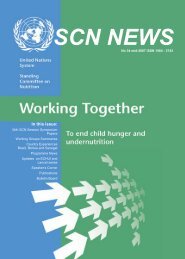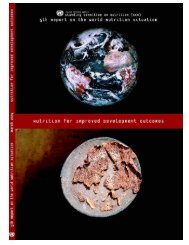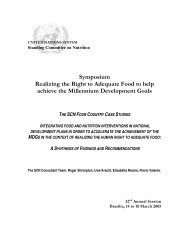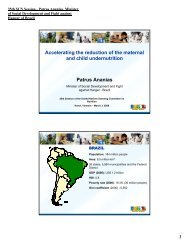Universal Salt Iodization (USI) - FTP Directory Listing
Universal Salt Iodization (USI) - FTP Directory Listing
Universal Salt Iodization (USI) - FTP Directory Listing
- No tags were found...
You also want an ePaper? Increase the reach of your titles
YUMPU automatically turns print PDFs into web optimized ePapers that Google loves.
6FEATURESSCN NEWS # 35 back to contentswww.unsystem.org/scnSocial and economic effects result from iodine deficiency in both human and animal populations. In humansthere is reduced school performance in children and reduced productivity in adults. Detailed calculations weremade of the economic costs of medical assessment and treatment of goitre in Germany where there was stillmuch uncontrolled IDD. The yearly costs of diagnosis were estimated at US$250 million, of treatment atUS$300 million, of hours lost in working time for this medical care at US$150 million, making a total ofUS$700 million a year (Pfannensteil 1985). There are also significant effects on all livestock with impairedreproduction in poultry, sheep, goats and cattle, with reduced wool growth and milk production and reducedrates of survival in offspring. Such effects indicate that correction of iodine deficiency has direct economicbenefits (Pandav and Rao 1997). The World Bank calculated that each dollar dedicated to IDD preventionwould yield a productivity gain of $28 (Levin et al 1993).The magnitude of IDDWHO estimated that there were in excess of 2.2 billion people from 130 countries at risk of IDD in the mid90s(Table 2). These countries include the most populous– Bangladesh, Brazil, China, India, Indonesia andNigeria (ICCIDD/WHO/UNICEF 1999). WithTable 1: The Spectrum of Iodine Deficiency Disorders (IDD)*the recognition that even mild iodineFoetusAbortionsdeficiency in the mother has effects on theStillbirthsrapidly growing foetal brain continuing intoCongenital Anomaliesthe first three years, and that these early effects,although preventable, are not reversi-Neurological cretinism: mental deficiency,Increased perinatal mortalityble (Hetzel 1983, 89), this global scourge isdeaf mutism, Spastic diplegia, squintNeurological Cretinismof such great magnitude, that it provides oneHypothryoid cretinism: mental deficiency,of the major challenges in internationaldwarfism, hypothyroidismhealth (Hetzel et al 2004).Psychomotor defectsBridging the gap betweenresearch and its applicationThere was an urgent need to bridge the greatgap between research on the subject ofiodine deficiency and brain damage and itsapplication in public health programmesthroughout the world. A beginning was madewith a Symposium in 1983 at the 4 th AsianCongress of Nutrition in Bangkok, whichagreed on the need for public health action(Lancet 1983). Subsequently in responseto an invitation to the AustralianGovernment from the UnitedNations Administrative Committeeon Coordination Sub-Committee onNutrition (ACC/SCN), a report with aproposal for a global preventionprogramme was prepared and submittedto the ACC/SCN early in1985. The report included a globalreview of the scientific evidence, amodel for a national programme anda proposal to establish the InternationalCouncil for Control of IodineDeficiency Disorders (ICCIDD). TheNeonateChild and adolescentAdultWHOregionsAll agesNeonatal hypothyroidismRetarded mental and physical developmentGoitre and its complicationsIodine Induced Hyperthyroidism (IIH)**GoitreHypothyroidismImpaired mental functionIncreased susceptibility to nuclearRadiation* Hetzel (1983, 1989); ** Transient following iodization, minimized byreduced rate of increase in iodine intake (WHO/UNICEF/ICCIDD 1996)Table 2: Estimates of population at risk of IDD by WHO regions in 1997*Countrieswith IDDTotal populationAt risk population**in IDD countriesMillions Millions % ***Africa 44 610 295 48%Americas 19 477 196 25%South-East Asia 9 1,435 599 41%EasternMediterranean17 468 348 74%Europe 32 670 275 32%Western Pacific 9 1,436 513 31%TOTAL 130 5,096 2,226 38%* Based on UN population Division (UN estimates 1997); ** The at risk populationis the population living in iodine deficiency areas where total goitre rate (TGR) ismore than 5%; *** Expressed as a percentage of the total population in the region(ICCIDD/WHO/UNICEF 1999)







